Area of a Triangle
Let us find a method to get the area of a triangle with an activity.
Activity: There are two copies of a triangle. Rotate the second triangle and place it such that the pair of corresponding sides are joined. Once you think they are joined properly drag and select both the triangles. The system will identify if you have placed it correctly or not.
${message}
The figure that we obtain is a
The area of the parallelogram will be the sum of the area of the two triangles, in other words - twice the area of the random triangle that we have cut out. Also, we observe that the base and the height of the triangle is equal to the base and the height of the parallelogram. Therefore,
Area of each triangle = (Area of parallelogram) = (base × height)
= b × h
Similarly, make random parallelograms on paper and cut them along the diagonal, so that two triangles are formed. Draw a line from C to B to cut it into two triangles.
Move the triangles around and see if they are congruent. Are the triangles obtained congruent?
Lets draw different triangles and explore more. In the below canvas, draw line from A to X,Y,C and from B to X,Y,C.
In the above figure, the threr triangles (∆ABC, ∆ABY and ∆AXY) are on the same base and have a common height.
Can we say all the triangles are equal in area?
Are the triangles congruent also?
All the congruent triangles are equal in area but the triangles equal in area need not be congruent
Let's Solve
One of the sides and the corresponding height of a parallelogram are 4 cm and 3 cm respectively. The area of the parallelogram (cm2)
- Fill in the blanks for the given area of parallelograms
| S.No. | Base | Height | Area of Parallelograms |
|---|---|---|---|
| (a) | 20 cm | 246 cm2 | |
| (b) | 15 cm | 154.5 cm2 | |
| (c) | 8.4 cm | 48.72 cm2 | |
| (d) | 15.6 cm | 16.38 cm2 |
Solution: Using the area of parallelogram formula:
Area of parallelogram = base × height
(a) Height = = = 12.3 cm
(b) Base = = = 10.3 cm
(c) Base = = = 5.8 cm
(d) Height = = = 1.05 cm
- Fill in the blanks for the given area of triangles
| S.No. | Base | Height | Area of Triangle |
|---|---|---|---|
| (a) | 15 cm | 87 cm2 | |
| (b) | 31.4 mm | 1256 mm2 | |
| (c) | 22 cm | 170.5 cm2 |
Solution: Using the area of triangle formula:
Area of triangle = base × height
(a) Height = = = 11.6 cm
(b) Base = = = 80 mm
(c) Height = = = 15.5 cm
What is the value of height ‘x’, if the area of the parallelogram is 24 cm2 and the base is 4 cm.
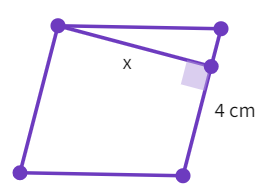
- We know that area of parallelogram is
- Putting the given values in the equation
- Solving to find the height which is
cm - Simplifying
- We have found the height
The two sides of the parallelogram ABCD are 6 cm and 4 cm. The height corresponding to the base CD is 3 cm. Find the:
(i) area of the parallelogram
(ii) the height corresponding to the base AD
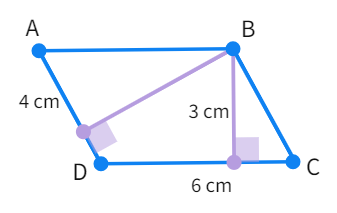
- Area of parallelogram =
cm 2 - Let the height corresponding to base AD be h . We also know that AD =
cm - We can write
cm 2 - Simplifying
- Calculating we get h =
cm - Finding the value of h i.e. required height.
In ∆PQR, PR = 8 cm, QR = 4 cm and PL = 5 cm (Check the below figure).
Find:
(i) the area of the ∆PQR
(ii) QM
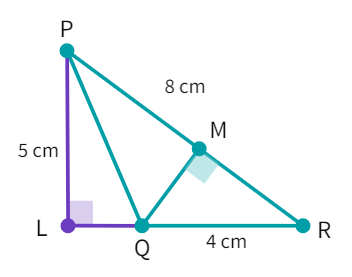
- From the fig., we can see that ∆PQR has base =
cm and height = cm - Thus, the area is equal to
cm 2 - We can use this area for finding QM (h) i.e the height and we already know that PR=
cm - Putting the values in the equation:
cm 2 - Simplifying
- Calculating
- We get QM =
cm - QM value is found
In parallelogram ABCD, DL and BM are the heights on the sides AB and AD, respectively. If the area of the parallelogram is 1470
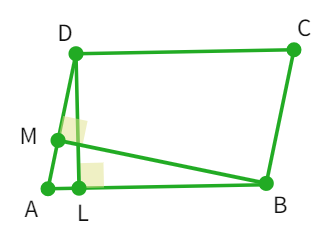
- From the fig., we know that parallelogram has area =
cm 2 - To find BM, we need to take
as base which has a value of cm - We can write:
cm 2 where BM = h - We get, BM = h =
cm - Similarly, to find DL we take
as base which has a value of cm - We can write:
cm 2 where DL = y - We get DL = y =
cm - BM and DL values have been found
∆ABC is right angled at A (shown below). AD is perpendicular to the side BC. If the length of the sides are: AB = 5 cm, BC = 13 cm and AC = 12 cm, find the area of ∆ABC. Also find the length of AD
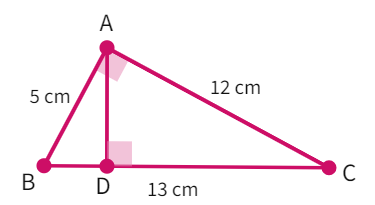
- From the figure, we can see that the sides:
acts as height and acts as base for the triangle (both are interchangeable) - Thus, the area is equal to
cm 2 - Using this area to find, AD where we have
acting as base. cm 2 where length of AD is s. - Simplifying
- Calculating i.e. s =
cm - Value of height AD
∆ABC is an isosceles triangle with AB = AC = 7.5 cm and BC = 9 cm. The height AD, from A to BC is 6 cm. What is the area of ∆ABC. Also find the height from C to AB i.e. CE?
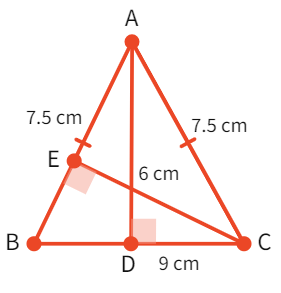
- From the figure, we can see that the area of the traingle can be sound using
as height and as base. - Thus, the area is equal to
cm 2 - Using this area to find CE where we have
acting as base (equal to cm). cm 2 where length of CE is h. - Simplifying
- Calculating i.e. h =
cm - Value of height CE
